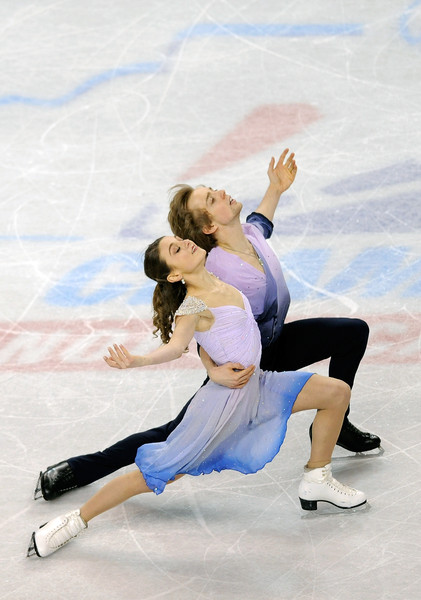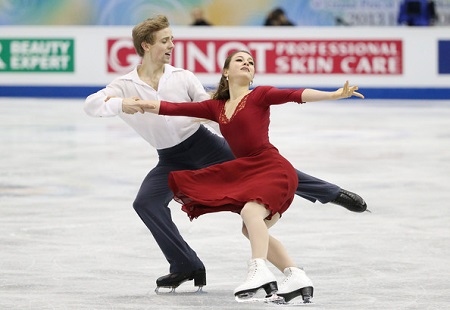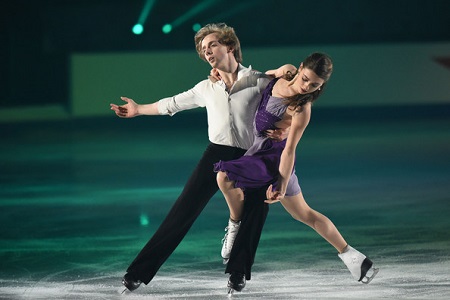by Jacquelyn Thayer
If American ice dancers Kaitlin Hawayek and Jean-Luc Baker know their stylistic strengths, they know even better how they aim to expand them — beginning with a season’s debut at this week’s Finlandia Trophy.
Their new short dance, featuring “Waltz of the Flowers” and “Dance of the Parents” from The Nutcracker, came through collaboration between the team and coach Anjelika Krylova as a vehicle to convey pure skating skills in a more classical manner.

Hawayek and Baker perform in the free dance at the 2015 Prudential U.S. Figure Skating Championships. Photo by Jared C. Tilton/Getty Images North America.
“It’s definitely a little harder because we’re very flowy skaters — we still have that flow within our music and in our skating, but rather than blending movements [in a contemporary way] as we have in the past, especially with our free dances, we have to really hit and finish our lines as you would in a ballet,” said Baker, who also highlighted the importance of performance quality to the program’s success.
“Ballets are so intricate with their choreography, but sometimes they can get boring as it’s hard to see the expression and whatnot,” he continued. “So we’re trying to draw out different expressions throughout the program as well.”
Krylova brought an experienced eye to the creative proceedings.
“Anjelika is born and raised in Russia, trained in Russia, and she’s got that classical ballet training, so when we were starting our short dance, she really had a good foundation to start with compared to us,” said Hawayek. “So I think she had an understanding of what needed to be incorporated in the program and then from there we kind of made it our own.”
And the coach’s high expectations led to a program that, Baker noted, utilizes nearly every beat or nuance of music—a tall order.
“When she finished choreographing it and we did a walk-through of it, she didn’t realize how fast she was making our turns and steps. She was like ‘Yeah, just do it like this, on this beat!’” said Baker. “Once we did the walk-through afterwards, Anjelika went ‘Oooooh. That’s harder than I thought it was.’”
“‘Oh, I made this program really hard,’” added Hawayek with a laugh.
“I don’t think she realized what she gave us,” continued Baker. “But Kaitlin and I both love the challenge, and we know it’s going to take time to get there — we’re still in the process of it, but we have a long season, hopefully, and hopefully by the end of the day we’ll be able to show it how we want it to be done.”
The effort to push themselves will continue via a free dance inspired by The Theory of Everything and its story of Jane and Stephen Hawking and the latter’s battle with ALS. Off the ice, the two have supported the cause for a cure, participating in last month’s Walk to Defeat ALS in Detroit.
On the job, they’ve worked with acting coaches in addition to their off-ice dance support staff, with an eye towards crafting something apart from their more romantic, traditionally lyrical free dances of the previous seasons.
“I don’t necessarily think it’s as lyrical as what we’ve done in the past because even though it’s more of a modern storytelling program, I think people will see a big difference in the way we’re skating it this year,” said Hawayek. “I think we’re actually more on the contemporary side than the lyrical, and I think some people kind of consider those two the same thing, but lyrical is very flowy, very one movement to the next. We do have some of that, but we also have a lot of contraction and release and holds and different aspects of the contemporary-style steps that we’re bringing in, and it’s a lot of movement that’s true and accurate to the actual ALS disease itself.”
“We don’t want it to come across as we’re trying to be too accurate with the movement, because it is still dance and it is still skating,” she concluded. “But at the same time, we want to portray and do this story justice, because it’s so emotional and so beautiful, and we don’t want people to lose the actual story within our skating.”
Baker, though, highlighted the difficulties inherent in defining a wide-ranging dance style as executed on ice.
“I think it’s really hard to justify the difference between lyrical/contemporary, because it’s all very similar — skaters have their specific style which they’re good at, and we are fluid within our program,” he said. “I think that this year, too, our free dance has a lot more of an emotional connection as well. We find that when we portray the characters within our program, we end up getting very drawn in and we finish programs like ‘Whoa, that was crazy,’ and it’s silent in the rink, and it’s just the way our skating portrays the story and everything like that.”

Hawayek and Baker perform in the free dance at the 2013-14 Grand Prix of Figure Skating Final. Photo by Atsushi Tomura/Getty Images AsiaPac.
Given the speed of their initial pairing — teaming up in the summer of 2012 just a matter of weeks before their first competition — the two only first had the chance to explore their creative inclinations in the season that culminated in a World Junior title.
“It was really more our second year, our Amelie program and our [quickstep] short dance that year that we both really started to come out of our shells when it came to being confident enough to collaborate with our coaches,” said Hawayek. “I think it gained a lot of respect from our coaches in that way because we both have visions and we like to show them that, and I think both of us have always had that side to us.”
But, as she observed, a push from their coaches — paired with a harmonious, “100 percent positive” relationship between the partners — can also draw out one of their primary strengths.
“We’re 100 percent devoted every single day of training, and we take critique and criticism really well in the way that both of us look for it,” she said. “We want people to tell us ‘You need to improve on this, you need to improve on that.’ We want other people’s input, so that’s why we’re constantly looking for people to work with and different eyes to give us feedback, because anything that someone has to say — we can always find a way to benefit from it.”
And after a year’s senior competition under their belts — one which included their first Grand Prix medal and a trip to the Four Continents Championships — the couple trusts that high-level experience and high-wattage training is key to further improvement.
“We always work our hardest on everything, but even in the jump from junior to senior last year, we always felt the most prepared we could be, and then going to those events, it was amazing,” said Baker. “We never felt unprepared, even when we saw other teams, but it was like, wow — just the difference in skating. Going to a Junior Grand Prix, you have about eight really good skaters and about ten that are okay. Going to a Grand Prix, it’s like eight people here could win. I could either be second or I could be last.”
“There’s no room for playing it safe, no room for holding back, because you have to do your job every single time you’re out there, and you have to show that you’re trained and you’re confident, too — I think that’s a huge thing,” said Hawayek. “If you go to a competition and you see the top teams out there, they get on the ice and they look and they think that they’re going to win, and that’s time and experience and that’s something we’re really working to grow upon in the next few years.”
“That’s definitely an approach we want to have this year,” added Baker with a laugh. “Whether it works or not, we won’t know until we do it, but you can only just train as hard as you can and then hope for the best, expect for the worst.”
Given the couple’s growing creative interests, seeking outside inspiration from the world of dance is another facet of that development. The two both credit the show So You Think You Can Dance as a major source, with Hawayek citing a particular admiration for Emmy-winning contemporary choreographer and dancer Travis Wall: “I’d love to work with him on the ice — that would be a dream.”
“Moreso off-ice than on-ice, you have the ability to be a little bit more creative because you don’t have those things called blades on your feet,” she said with a laugh. “it’s definitely really inspiring to watch them have that ability to be so creative, and then we can kind of take ideas from what they’re doing off the ice and translate it onto the ice.”
And the team’s involvement since 2014 with Skate Dance Dream, an annual touring show integrating on and off-ice performances, has also joined them with So You Think You Can Dance alums like Audrey Case and Ashleigh and Ryan Di Lello.
“We’ve loved the experience — it’s given us that connection to dance and both of us really love that,” said Hawayek. “We’ve gotten to meet some incredible dancers — there’ve been a few that have been to both of the shows that we’ve done, so we’ve kind of made a connection and a friendship through that. It’s just another chance to perform and we love performing.”

Hawayek and Baker perform in the gala at 2014 NHK Trophy. Photo by Atsushi Tomura/Getty Images AsiaPac.
The freedom of exhibition and show skating has given the team their greatest opportunity to experiment in the choreographic realm. “It’s almost like one of our coaches is supervising us when we’re doing a show program just to make sure that if we come up with something that really doesn’t look good…” said Hawayek. “They’ll let us know,” interjected Baker.
“I mean, that rarely happens,” continued Hawayek. “But it’s just kind of someone to keep an overall eye on what we’re doing, especially in show programs, we really like to be experimental and work between each other and try to come up with different things.”
Baker’s also found a creative outlet with coach and dance instructor Anna Matuszewski — a choreographer and dancer for rap artist Macklemore — by blocking out a little time to film skating videos, including one this past off-season set to Maurice Ravel’s Bolero.
“She’s a figure skating coach in Olympicview Ice Arena, where I learned how to skate, from day one, basically, up until I moved to Detroit,” said Baker, who also took hip hop from Matuszewski. “She’s really cool and she just has some wacky ideas that she knows she can think of and she’ll just say it and I’ll make it up and do it. We just like to mess around and collaborate, because it’s during my vacation time when I go home.”
“I think that Anna has some crazy cool ideas and she knows that Jean-Luc is one of the only people that she can actually try them on and have it look the way that she imagines them,” added Hawayek.
The two, though, are finding their artistic perspective together, and it’s a unity they carry through their work.
“When we get to competitions, to be honest, as soon as we step into that rink, it’s Jean-Luc and I,” said Hawayek. “Our coaches are there and they’re there to support us, and we feed off of that and we listen to them before we compete. But really, when we get to that rink, it’s kind of like we have our blinders on, and all we can see is each other. Because ultimately, when you’re on the ice, it’s just the two of you, so why not completely devote each other’s focus to each other?”
